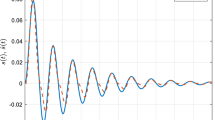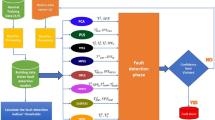Abstract
Most research in fault diagnosis of discrete event systems has been focused on permanent failures. However, experience with monitoring of dynamic systems shows that intermittent faults are predominant, and that their diagnosis constitutes one of the most challenging tasks for surveillance activities. Among the main existing approaches to deal with permanent faults, two were widely investigated while considering different settings: the Diagnoser based approach, and the Twin-plant based approach. The latter was developed to cope with some complexity limitations of the former. In the present paper, we propose a twin-plant based approach to deal with diagnosability of intermittent faults. Firstly, we discuss various notions of diagnosability, while considering the occurrence of faults, their recovery, and the identification of the system status. Then, we establish the necessary and sufficient conditions for each notion, and develop on-the-fly algorithms to check these properties. The discussed approach is implemented in a prototype tool that is used to conduct experiments on a railway control benchmark.
Similar content being viewed by others
References
C. Cassandras and S. Lafortune, Introduction to Discrete Event Systems, Springer Science & Business Media, 2009.
J. Zaytoon and S. Lafortune, “Overview of fault diagnosis methods for discrete event systems,” Annual Reviews in Control, vol. 37, no. 2, pp. 308–320, 2013.
M. Sampath, R. Sengupta, and S. Lafortune, “Diagnosability of discrete-event systems,” Transactions on Automatic Control, vol. 40, no. 9, pp. 1555–1575, 1995.
S. Jiang, Z. Huang, V. Chandra, and R. Kumar, “A polynomial algorithm for testing diagnosability of discrete-event systems,” IEEE Transactions on Automatic Control, vol. 46, no. 8, pp. 1318–1321, 2001.
T. S. Yoo and S. Lafortune, “Polynomial-time verification of diagnosability of partially observed discrete-event systems,” IEEE Transactions on Automatic Xontrol, vol. 47, no. 9, pp. 1491–1495, 2002.
J. Liu, Z. Zhou, and Z. Wang, “Online fault diagnosis in discrete event systems with partially observed petri nets,” International Journal of Control, Automation and Systems, vol. 16, no. 1, pp. 217–224, 2018.
A. Zimmermann, Stochastic Discrete Event Systems, Springer, 2007.
D. Thorsley and D. Teneketzis, “Diagnosability of stochastic DESs,” IEEE Transactions on Automatic Control, vol. 50, no. 4, pp. 476–492, 2005.
F. Liu and D. Qiu, “Safe diagnosability of stochastic discrete event systems,” IEEE Transactions on Automatic Control, vol. 53, no. 5, pp. 1291–1296, 2008.
F. Liu, D. Qiu, H. Xing, and Z. Fan, “Decentralized diagnosis of stochastic discrete event systems,” IEEE Transactions on Automatic Control, vol. 53, no. 2, pp. 535–546, 2008.
D. Qiu, “Supervisory control of fuzzy discrete event systems: a formal approach,” IEEE Transactions on Systems, Man, and Cybernetics, Part B (Cybernetics), vol. 35, no. 1, pp. 72–88, 2005.
W. Deng and D. Qiu, “Bifuzzy discrete event systems and their supervisory control theory,” IEEE Transactions on Fuzzy Systems, vol. 23, no. 6, pp. 2107–2121, 2015.
D. Qiu and F. Liu, “Fuzzy DESs under fuzzy observability and a test algorithm,” IEEE Transactions on Fuzzy Systems, vol. 17, no. 3, pp. 578–589, 2009.
F. Liu and D. Qiu, “Diagnosability of fuzzy discrete-event systems: A fuzzy approach,” IEEE Transactions on Fuzzy Systems, vol. 17, no. 2, pp. 372–384, 2009.
W. Deng and D. Qiu, “State-based decentralized diagnosis of bi-fuzzy discrete event systems,” IEEE Transactions on Fuzzy Systems, vol. 25, no. 4, pp. 854–867, 2017.
W. Deng and D. Qiu, “Supervisory control of fuzzy discrete-event systems for simulation equivalence,” IEEE Transactions on Fuzzy Systems, vol. 23, no. 1, pp. 178–192, 2015.
O. Contant, S. Lafortune, and D. Teneketzis, “Diagnosis of intermittent faults,” Discrete Event Dynamic Systems: Theory and Applications, vol. 14, no. 2, pp. 171–202, 2004.
A. Correcher, E. Garcia, F. Morant, and E. Quiles, “Intermittent failure diagnosis in industrial processes,” Proc. of IEEE International Symposium on Industrial Electronics, vol. 2, pp. 723–728, 2003.
S. Biswas, “Diagnosability of discrete event systems for temporary failures,” Computers & Electrical Engineering, vol. 38, no. 6, pp. 1534–1549, 2012.
L. K. Carvalho, M. V. Moreira, and J. Basilio, “Diagnosability of intermittent sensor faults in discrete event systems,” Automatica, vol. 79, pp. 315–325, 2017.
E. Fabre, L. Hélouët, E. Lefaucheux, and H. Marchand, “Diagnosability of repairable faults,” Discrete Event Dynamic Systems, vol. 28, no. 2, pp. 183–213, Jnue 2018.
A. Boussif, B. Liu, and M. Ghazel, “A twin-plant based approach for diagnosability analysis of intermittent failures,” Proc. of International Workshop on Discrete Event Systems, IEEE, pp. 237–244, 2016.
M. Moreira, T. Jesus, and J. Basilio, “Polynomial time verification of decentralized diagnosability of discrete event systems,” IEEE Transactions on Automatic Control, vol. 56, no. 7, pp. 1679–1684, 2011.
P. Mateti and N. Deo, “On algorithms for enumerating all circuits of a graph,” Journal on Computing, vol. 5, no. 1, pp. 90–99, 1976.
D. B. Johnson, “Finding all the elementary circuits of a directed graph,” Journal on Computing, vol. 4, no. 1, pp. 77–84, 1975.
A. Boussif and M. Ghazel, “DIAG-IPF: a software tool for fault diagnosis of discrete event systems,” Proc. of the 11th Colloque sur la Modélisation des Systèmes Réactifs, 2017.
B. Liu, M. Ghazel, and A. Toguyéni, “Model-based diagnosis of multi-track level crossing plants,” IEEE Transactions on Intelligent Transportation Systems, vol. 17, no. 2, pp. 546–556, 2016.
M. Ghazel and B. Liu, “A customizable railway benchmark to deal with fault diagnosis issues in DES,” Proc. of Intern. Work. on Discrete Event Systems, pp. 177–182, 2016.
S. Jiang, R. Kumar, and H. E. Garcia, “Diagnosis of repeated/intermittent failures in discrete event systems,” IEEE Transactions on Robotics and Automation, vol. 19, no. 2, pp. 310–323, 2003.
T. S. Yoo and H. E. Garcia, “Event diagnosis of discrete-event systems with uniformly and nonuniformly bounded diagnosis delays,” Proc. of American Control Conference, vol. 6, pp. 5102–5107, 2004.
S. Jiang and R. Kumar, “Diagnosis of repeated failures for discrete event systems with linear-time temporal-logic specifications,” IEEE Transactions on Automation Science and Engineering, vol. 3, no. 1, pp. 47–59, 2006.
C. Zhou and R. Kumar, “Computation of diagnosable fault-occurrence indices for systems with repeatable-faults,” IEEE Transactions on Automatic Control, vol. 54, no. 7, pp. 1477–1490, 2009.
A. Boussif and M. Ghazel, “A diagnoser-based approach for intermittent fault diagnosis of discrete-event systems,” Proc. of American Control Conference (ACC), IEEE, pp. 3860–3867, 2017.
S. Hashtrudi Zad, R. H. Kwong, and W. M. Wonham, “Fault diagnosis in discrete-event systems: Framework and model reduction,” IEEE Transactions on Automatic Control, vol. 48, no. 7, pp. 1199–1212, 2003.
A. Boussif and M. Ghazel, “Formal verification of intermittent fault diagnosability of discrete-event systems using model-checking,” International Journal of Critical Computer-Based Systems, vol. 8, no. 2, pp. 193–213, 2018.
Author information
Authors and Affiliations
Corresponding author
Additional information
Publisher’s Note Springer Nature remains neutral with regard to jurisdictional claims in published maps and institutional affiliations.
Recommended by Associate Editor Jiuxiang Dong under the direction of Editor Guang-Hong Yang. The authors acknowledge the support of the ELSAT2020 project. ELSAT2020 is co-financed by the European Union with the European Regional development Fund, the French state and the Hauts de France Region Council.
Abderraouf Boussif received his B.Eng. degree in system control engineering from the Polytechnic High School, Algeria, in 2012, his master degree in complex systems engineering from the École Normale Supérieure de Cachan, Paris, in 2013, and a Ph.D. degree in safety system engineering from the University of Lille, France, in 2016. He is currently a Researcher with the France’s Railway Technological Research Institute-Railenium. His research interests are mainly in formal methods, modelbased safety analysis, and fault diagnosis of safety-critical systems, with a particular emphasis on railway control systems.
Mohamed Ghazel is a Research Director with the COSYS/ESTAS team at IF-STTAR (The French Institute of Science and Technology for Transport, Development and Networks). He received his Master’s and Ph.D. degrees in automatic control and industrial computer sciences from École Centrale de Lille/University of Lille, in 2002 and 2005, respectively; and the HDR (Habilitation à Diriger des Recherches) from University Lille Nord de France in 2014. His research mainly focuses on the engineering, safety and interoperability of transportation systems using discrete event models and formal methods. Dr. Ghazel is a member of the IFAC TC 7.4 on Transportation Systems, he has been involved in several national and European research projects and acts as expert for the European Commission in the framework of innovation programs.
Rights and permissions
About this article
Cite this article
Boussif, A., Ghazel, M. Diagnosability Analysis of Intermittent Faults in Discrete Event Systems Using a Twin-plant Structure. Int. J. Control Autom. Syst. 18, 682–695 (2020). https://doi.org/10.1007/s12555-018-0682-9
Received:
Revised:
Accepted:
Published:
Issue Date:
DOI: https://doi.org/10.1007/s12555-018-0682-9




